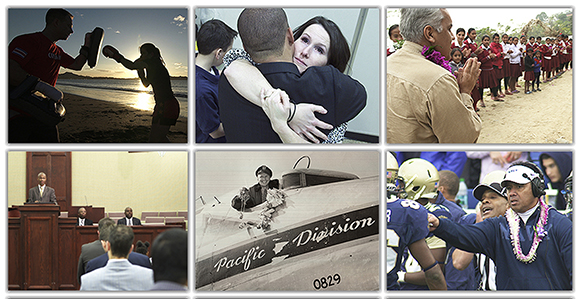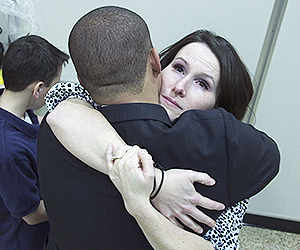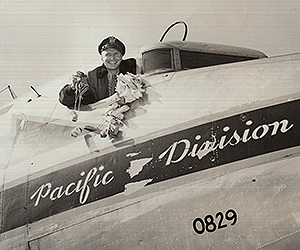Meet the Mormons Now 37th of All Documentaries
Contributed By R. Scott Lloyd, Church News staff writer

The success of Meet the Mormons, the Church’s first venture into showing a motion picture in commercial theaters, has exceeded all expectations.
Related Links
The success of Meet the Mormons, the Church’s first venture into showing a motion picture in commercial theaters, has exceeded all expectations. After just 10 days, it ranks as the 37th most successful documentary ever.
The movie premiered October 7 at a theater in Sandy, Utah, and was released October 10 at 317 theaters in 45 states, becoming the number 1 film in 100 of them. In its first week, the film finished as the 10th highest grossing film in the nation and one of the top 100 documentaries of all time.
The number of screens showing the film expanded to 333 on October 17, with more planned. That’s more than twice as many screens as initially planned, but the demand had already increased, driven by word of mouth and social media. It is anticipated the movie will eventually be shown internationally, as well as in visitors’ centers and at the Legacy Theater in the Joseph Smith Memorial Building in Salt Lake City.
It was initially planned for exclusive showing there, but filmmakers and Church leaders began to think big at the urging of an outside firm.
“As we first started talking about a release in commercial theaters, even I was shocked,” director Blair Treu admitted. “But as we’ve watched the audiences respond in previews, I’m not fearful now; I’m pretty calm.”
It was Brother Treu who, in a brainstorming meeting to discuss making a new film for the Legacy Theater, suggested the idea of the documentary. “My hand shot up. I said, ‘Let’s show the world who we are, mostly through the perspective of our members, rather than through the details of our beliefs.’”
It stemmed from a longing he’d had as a youth growing up in the Church. “I thought, ‘If people just knew us, they wouldn’t say such terrible things about us. Their perspective of who we are would change if they just knew us better.’”
Brother Treu pitched the idea to Church leaders, who sent him out to make an advance trailer, filming prototypical interviews in Europe, Asia, South America, and the United States.
“We showed it to President Thomas S. Monson,” Brother Treu recounted. “He said, ‘I love it; go do it.’”
It was the Church President, in fact, who named the film, reusing a title that was given to a film he was involved with as a member of the Quorum of the Twelve Apostles back in the early 1970s, one that was used extensively in missionary work with a similar concept but not nearly on the scale of this one.
“The title is out front,” Brother Treu noted, “not meant to deceive anybody. In the opening [consisting of on-the-street interviews conducted by host Jenna Kim Jones], we kind of acknowledge, ‘We understand this is what you might think about us. And guess what? That’s OK. We’ll even have a laugh along with you. But we invite you to look at us from a different point of view.’ ”
What has come about is a glimpse into the lives of a half-dozen Mormons, diverse in background and demographics but alike in their devotion to and love for their faith. Five of the six were in town October 7 for interviews.
 Carolina Munoz Marin
Carolina Munoz Marin
Sister Marin is a Central American kickboxing champion, ranked number 2 in the world, yet maintains a busy schedule as the mother of two young boys and co-owner with her husband of a martial arts school. She teaches the young single adult Sunday School class in her ward in Cost Rica.
Sister Marin was found by two female missionaries and joined the Church before her marriage.
She knew her martial arts trainer, Milton Marin, was a Latter-day Saint, so she posed some questions to him about the faith. “I helped her too much,” quipped Brother Marin, a third-generation Latter-day Saint, which is rare in Costa Rica. “I took her all the way to the temple.”
The two were married a few years after Carolina’s baptism.
“And now, we’re four,” he said, alluding to sons Luis Diego, 5, and Andreas, 4.
Sister Marin said her faith brings her a feeling of security “when you know you’re choosing the right things to do and you know you’ll be blessed for it. Before my fights, I say a prayer, and I ask not to win or lose but I ask that we can finish the fight without any injury to me or my opponent and do the best we can. To know my Heavenly Father is hearing me and loving me is really important for me in my sport and in my life.”
 Dawn Armstrong
Dawn Armstrong
A single mother, Sister Armstrong had just left a homeless shelter in Iowa and moved into an apartment, promising her 18-month-old son that they would never be homeless again, when she met two Mormon missionaries at a neighbor’s apartment.
“You should come to my house; I love to talk,” Sister Armstrong told them.
“After they picked their jaws up off the floor, they came.”
She joined the Church after the death of her second child from a metabolic defect. It was a turning point in her life.
She moved to Salt Lake City, where she met Craig Armstrong at Shriners Hospital. Born without a leg, he had been treated there as a child and now, as a certified prosthetist, he was working in a career in which he could “give back.”
A romance blossomed, they were married, and her son Anthony and deceased boy Tre were sealed to them in the temple. Six other children have been born to them.
In the movie, Anthony is preparing to leave on a mission for the Church to Durban, South Africa.
Regarding the movie, Sister Armstrong said, “This whole thing for me has been about giving hope to the hopeless and truly representing from our own mouths who we are.”
It’s an outlook, she said, that has come from past “warm and wonderful” relationships she has had with people of various faiths. “I never think of myself as Dawn, Mormon, I think of myself as Dawn, lover of all.”
 Bishnu Adhikari
Bishnu Adhikari
Brother Adhikari left his village in Nepal to study engineering in Russia. As a student there, he found the Church, which nurtured his innate desire to help those less fortunate than he.
“I went to the post office to drop off my letters home,” Brother Adhikari recalled. “On the post office wall there was a notice that missionaries from the LDS Church were in town and would be meeting at such and such a place.”
Christianity had been fascinating to him from the days he attended a Christian school when he was 14, and he thought now would be a good time to learn more.
But he couldn’t find the location and was about to return home to escape the ravages of a February blizzard. Near the trolley station, he spotted the meeting location. The meeting was over, but the missionaries were still there, and they taught him, leading to his acceptance of the gospel.
After returning home, he married his sweetheart, Mangala, and she eventually joined the Church. They have three children.
Today, Brother Adhikari travels to remote villages in the Himalayas to build roads, schools, and water systems. It’s in line with a motivation borne of his circumstances and upbringing. “Of course, after my conversion, the gospel, the Christlike motto of serving others, reinforced that feeling, and now I have a strong commitment and desire to continue the rest of my life to find a solution to ending poverty.”
 Jermaine Sullivan
Jermaine Sullivan
It was a Church media campaign, a TV spot offering a free copy of the Lamb of God video, that first brought the Church into the life of Brother Sullivan, a young black man growing up in Tuscaloosa, Alabama.
“They gave out a toll-free number, and I jumped up and said, ‘I need to call that number,’” Brother Sullivan recalled. “The missionaries came maybe three days later, and they taught me.”
The story of Joseph Smith’s youth in wondering which of all churches was right resonated with Brother Sullivan. “I guess I naively thought I was the only one who wondered why there isn’t just one church. Just hearing his experience captured my attention. I was captivated by that and everything else they taught, and here we are.”
He moved to Atlanta, where he received his education and married his wife Kembe. They have three children.
He was a bishop for six years until 2012, when he was released and became president of the Atlanta Georgia Stake.
Working professionally as an academic counselor, he has carried over into his Church service his desire to help people improve their education. As a bishop, he established in the ward a program to help people earn their GED certificate.
Asked about society’s greatest need today, President Sullivan said, “We have to learn how to love one another, respect one another. Although there may be differences, we have to be kind. We have to be firm in the truth as well, but let’s not forget to be kind and loving to one another.”
 Gail Halvorsen
Gail Halvorsen
The legendary “candy bomber” is the final subject in Meet the Mormons. He is the American pilot whose compassion for a rag-tag group of 30 German children gathered on the other side of barbed wire at a landing base during the Berlin Airlift just after World War II led to his dropping chocolate bars with parachutes from the sky.
“I had nightmares!” recalled Brother Halvorsen, who was a stickler for obeying regulations. “I was worried about getting caught!”
But Brother Halvorsen could not resist the urge to be charitable as he interacted with the curious youngsters, who peppered him with questions about the airplanes and the flights as he stood waiting for a Jeep to go spend some leisure time shooting home movies around West Berlin.
“I turned to leave and suddenly realized not one of those kids had begged for candy from me,” he said. “Why? Because they were so grateful for flour. They wouldn’t lower themselves to beg for something so extravagant as chocolate.” What he did after that he doesn’t take any great credit for. Under the circumstances, he said, “Scrooge would have done the same thing.”
He reached in his pocket and gave the children the only goodies he had: two sticks of Wrigley’s Doublemint chewing gum. These they gratefully shared as best they could; those who did not get any of the gum were grateful for portions of the wrappers they could sniff and take home to show their parents.
Then, Brother Halvorsen hatched an idea on the spot. He told the children to be at the field and watch for him to wiggle the wings of his aircraft as he returned the next day from delivering food supplies. He would drop chocolate bars to them, enough for everyone to have some, if they promised to share.
“Jawohl!” they exclaimed repeatedly.
Brother Halvorsen and his buddies pooled their chocolate bar rations and for three straight weeks dropped the candy to the excited children.
His fear was realized: he was called on the carpet by the commanding colonel in Berlin. But by then, the top brass had heard about his venture, and his early effort eventually expanded to involve other participants, with candy companies and other donors back home in the United States joining in.
“Two sticks of gum went to 23 tons of chocolate dropped from the sky over that year,” said Brother Halvorsen, who, applying precepts from his Mormon faith, added that the German kids had taught him principles of service before self and having an attitude of gratitude.
 Ken Niumatalolo
Ken Niumatalolo
In addition to the foregoing five Latter-day Saints, the movie also profiles Brother Niumatalolo, who was not in town the day the other five were interviewed.
As head football coach of the U.S. Naval Academy in Annapolis, Maryland, he balances the pressure of his job by putting his family and faith first. He raised some eyebrows when he made the decision to cancel staff meetings on Sundays, traditionally seen as critical to the team’s success. But, as told in Meet the Mormons, the decision has turned out for the best.
For more information on the motion picture, including a request form to fill out asking that the movie be shown in a particular area, go to www.meetthemormons.com.
